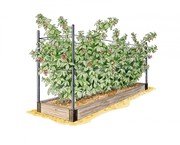Berry beds provide a most attractive ornamental feature in any garden, large or small, and can be inexpensive and easy to construct. A more permanent, high-quality structure can make a big difference to an otherwise unremarkable garden. Raised beds filled with suitable compost provide the special conditions needs for all ericaceous berry plants, enabling gardeners who do not have the naturally acidic free-draining soil needed for these plants to widen their horizons and to enjoy both their edible fruits and the year-round ornamental interest.
Berry beds can be of any size or shape and be designed to the scale of the garden and owners' taste. Different materials can act as soil-retaining edging.
A bed with a surface areas of about 7 sq. ft. (2 sq. m) should accommodate two of the more compact North American highbush blueberries, one southern highbush and one or twol half highs. At least 6 cranberries and 12 lingonberries can be added to cover the ground. A flat stone placed here and there will mean not trampling on the cranberries when harvesting the blueberries.
1. Mark the outline of the site to be constructed. The shape can be square, rectangular, circular, semicircular or any other shape that fits in with the existing or planned design of the site. A basic bed to suit most situations is 6 ft. x 6 ft. (1.8 m x 1.8 m) and about 3 1/3 ft. (1m) deep.
2. Dig out up to 12 in. (30 cm) of the soil within the marked-off area. Retain the soil and mit it later with organic ingredients if its pH is 6.0 or less. Remove the soil if the pH is above 6.0. If building a retaining wall of stone or brick, lay foundations and build the wall, leaving drainage holes. If using log rolls, split poles, wooden boarding or planks of wood or other material, you will need to incorporate vertical supporting posts.
3. Mix the materials that will form the compost and fill the bed very near to the top of the retaining wall, bearing in mind that organic matter will shrink as it decays.
4. Plant up the bed and water it thoroughly.
5. It is a good idea to plan for when the fruit appears. When the blueberries begin to show the slightest color, they must be protected from birds and berry-eating mammals. Either purchase or build temporary fruit cages that allow access and remove them once the crop is harvested.

